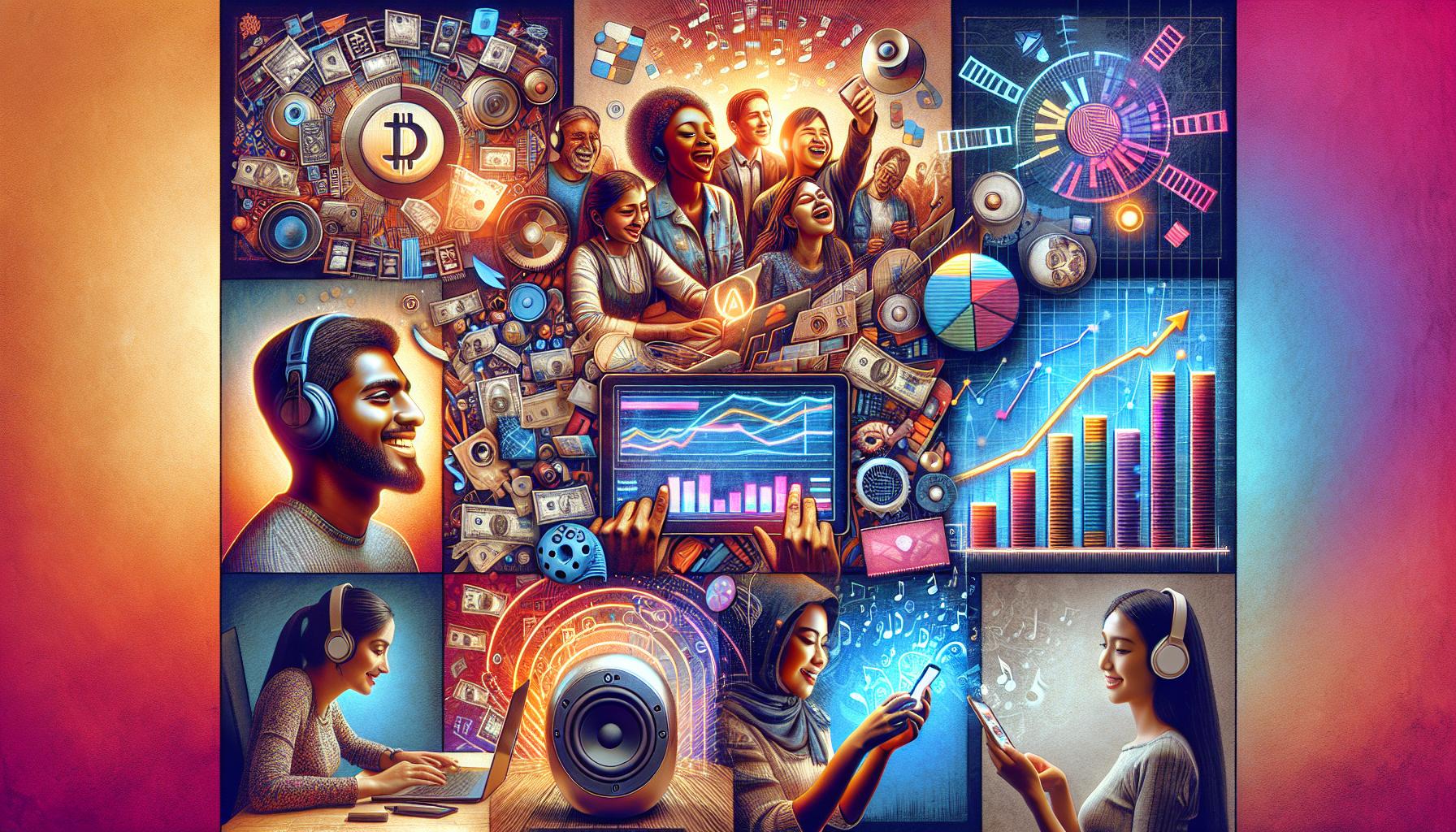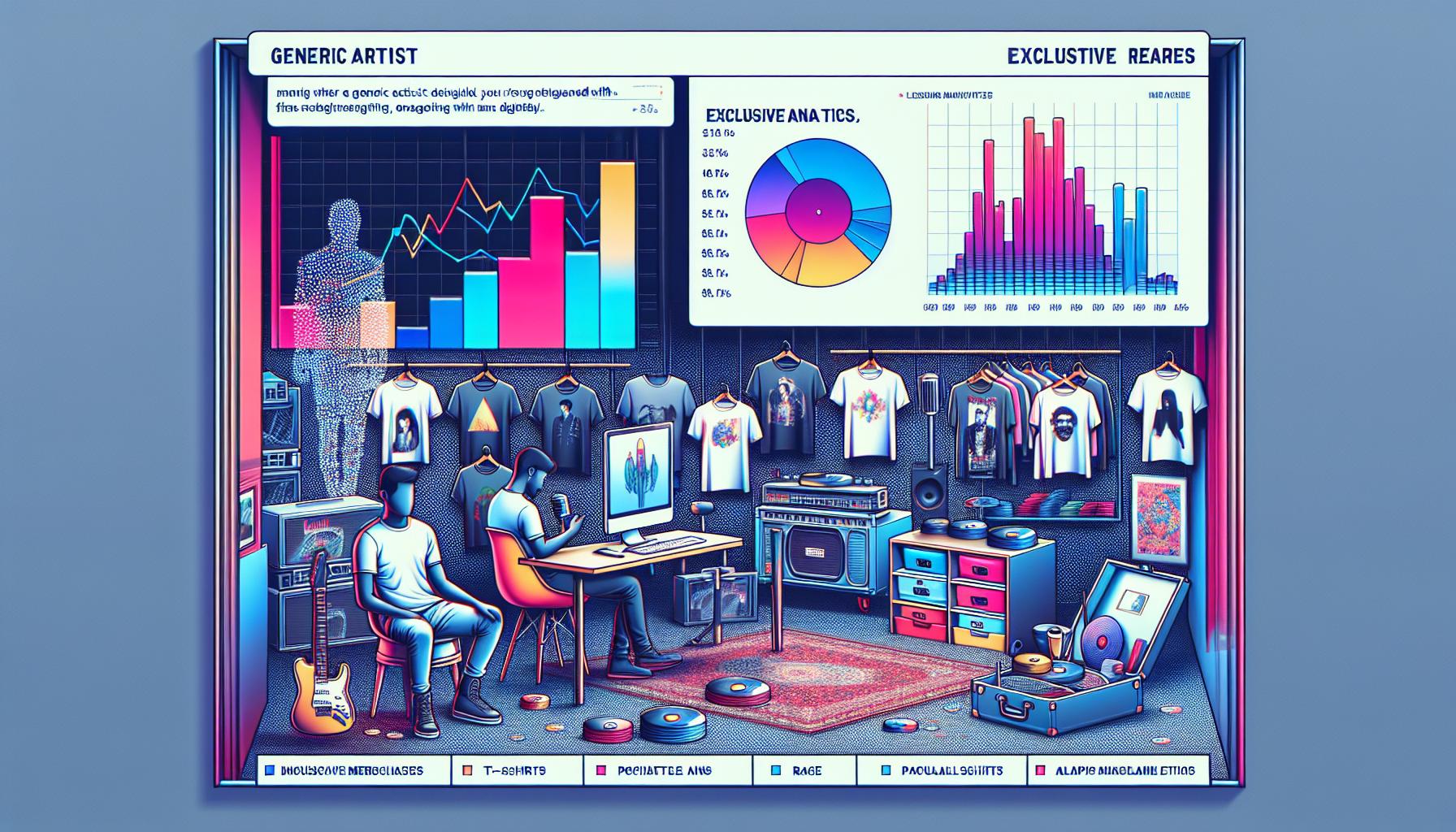As an artist or music industry professional, you’re likely aware of the staggering growth of music streaming platforms. They’ve become the go-to solution for millions of music lovers worldwide. But how can you turn these digital platforms into a lucrative revenue stream? That’s what I’ll be exploring in this article.
Music streaming platforms like Spotify, Apple Music, and Tidal have revolutionized the way we consume music. Yet, for many artists, the path to monetizing these platforms remains murky. I’m here to shed some light on this topic and provide actionable strategies to maximize your revenue.
Contents
Understanding the Music Streaming Landscape
The music streaming landscape is a rapidly expanding ecosystem. It’s crucial we get a handle on the mechanics of this digital panorama, to thrive in it effectively. It’s not simply about uploading songs; that’s simply scratching the surface. Understanding the core of these platforms, their algorithms, and interaction measures can transform them into a gold mine for artists and industry professionals alike.
Spotify, Apple Music, Tidal, and other similar platforms are famous examples of streaming services. These platforms have quite literally changed the game, shifting the paradigm from physical media to digital consumption. Remarkably, these platforms aren’t just the future – they are the present. Global statistics showed that in 2020, 83% of recorded music revenue came from streaming, a testament to its prevalence.
Given the market’s orientation, it’s time we looked closely at these platforms’ operation. Spotify’s algorithm, for instance, takes into account factors like track popularity and listener engagement when deciding how often to feature the track. Similarly, Apple Music considers first-week plays very important in influencing its algorithm.
What does this mean for you? Simply, it’s not just about the music; it’s also about understanding these platforms’ behavior. Professional artists and those at the beginning of their journey should aim to grasp these platforms’ inner workings, learn about the algorithms, and continuously adapt their strategies to feed into these systems.
It’s also essential to recognize that not all streaming platforms function the same way. Differences between the algorithms and payout systems of these platforms can influence an artist’s revenue substantially. A deep dive into these peculiarities can act as a guide to strategize and optimize content for each platform thereby creating a significant impact on your overall earnings.
In the upcoming sections, we will explore several actionable strategies to help optimize your music and make the most of these platforms. By using these strategies effectively, artists can not only enhance their reach but also steadily increase their revenue stream from these platforms.
The Potential of Music Streaming Platforms

Well now, let’s dive deep into the potential of music streaming platforms. It’s no secret that streaming platforms have quickly become a cornerstone of the music industry. In 2020 alone, these platforms accounted for a whopping 83% of recorded music revenue. Such platforms can offer an increasingly lucrative revenue stream for budding artists and music industry professionals. They’ve opened new avenues of growth and opportunities that were unimaginable just a few years back. To tap into these opportunities, understanding the nitty-gritty of these platforms becomes crucial.
Music streaming platforms are not just about streaming your favorite tracks. They’re also about building an active community of loyal fans. Successful artists on these platforms are those who understand that interaction measures matter. Engaging with fans on these platforms can help artists build their brand, attract new listeners, and enhance their discoverability. This isn’t just boosting their social presence but also their revenue.
Another key element lies in the algorithm of these platforms. Each one has its own specificities. Some favor new releases, others give more visibility to well-liked tracks, and some prioritize engagement. Artists need to adapt their musical strategies according to the behavior of each platform’s algorithms and payout systems. It’s not just about getting the song on the platform; it’s about making it visible and driving streams.
Given the immense potential these platforms hold, it becomes evident how vital it is to approach them with an informed strategy. It’s necessary to embrace a multi-faceted approach, incorporating smart marketing, quality music, and consistent interaction measures with the fan base, all tailored to suit each platform’s algorithm and payout system.
The following paragraphs will delve deeper into how artists can structure their strategies and boost their earnings from music streaming platforms.
Challenges Faced by Artists in Monetizing Streaming Platforms

As we delve into the complexities of music streaming platforms, it’s critical that we understand the challenges artists often encounter when attempting to monetize their work. Remember, it’s a tricky but worthwhile endeavor.
The first obstacle they face is the Algorithm Dilemma. Most platforms utilize complex algorithms to suggest music to listeners. Understanding these can be a demanding task. However, it’s essential to target and optimize releases to suit the platform’s algorithm behavior for maximum exposure and engagement.
Next, comes the Balance of Quality and Quantity. Artists continuously grapple with maintaining their art’s integrity while churning out a considerable volume of work. More releases, quite often, mean better visibility and, subsequently, higher revenue on streaming platforms.
Let’s break down these challenges:
- Algorithm Dilemma
- Complexity of understanding
- Enigma of optimizing releases
- Balance of Quality and Quantity
- Preserving artistic integrity
- Ensuring adequate volume of work
Artists face a final hurdle in the form of an Inconsistent Payout System. Different platforms have different payout ratios, complicating artists’ revenue predictability. Not to mention the varying percentages taken by labels and distribution companies.
Here’s a quick comparison of popular streaming platforms’ approximate payout per stream:
| Platform | Payout per stream |
|---|---|
| Apple Music | $0.00735 |
| Spotify | $0.00437 |
| TIDAL | $0.00927 |
Having shed light on these challenges, it’s clear artists require careful strategizing and adaptability to make the most out of music streaming platforms. In the next sections, we will address the importance of building an engaged community and how to navigate the aforementioned issues. Through shared wisdom, we strive to help artists flourish in the complex world of music streaming.
Creating a Compelling Presence on Music Streaming Platforms
To win in the competitive landscape of music streaming, an artist needs to master the art of standing out. It’s not always about spinning out tracks quickly. Sometimes, it’s about sharing pieces that resonate with your audience, and keeping the engagement flowing.
Firstly, understanding one’s audience is crucial. It’s what sets the journey’s direction. By diving into analytics, artists can determine their audience’s size, demographics, and listening habits. For many popular music streaming platforms such as Spotify, Apple Music and Deezer, this type of data is readily available for artists to access. This allows you to tailor your releases to better match your audience’s preferences.
Secondly, effectively optimizing release schedules is another critical aspect. It’s not just about selecting top hits, but timing them right too. Scheduled releases at opportune times that match your audience’s active hours, can lead to higher engagement and increased exposure.
| Metric | Importance |
|---|---|
| Audience Data | Understanding size, demographics, listening habits |
| Release Schedule | Timing releases to ensure maximum exposure |
| Quality Content | Balancing quality and quantity of work |
Moreover, defining a unique brand identity through your music and visual content helps attract and retain listeners. Branding, album covers, and music videos all play a part in defining who you are as an artist and help to create a compelling presence on any music streaming platform. These platforms also provide options and features to customize your profile and better reflect your unique artistic brand.
Moving on from this, it’s important to foster interaction with listeners, nurturing relationships through engagement via social media or within the platform itself. Live sessions, Q&As, and playlists create a space for listeners to connect with the artist on a personal level.
Lastly, strategic collaborations with other artists can increase outreach. Cross-promotions, featuring in playlists, or collaborative tracks can give your brand visibility that would be hard to achieve alone. It’s essential that these collaborations align with your brand and resonate with your listeners. Collaborations are not just about exposure but about showing your audience and potential listeners what you’ve got.
So there you have it. Creating a compelling presence on music streaming platforms involves understanding your audience, optimizing your release schedules, defining a unique brand identity, fostering interaction with listeners, and pursuing strategic collaborations.
Maximizing Revenue Through Playlisting

When it comes to enhancing streams and visibility on platforms, playlisting is a game-changer. Strategically making your way onto popular playlists could significantly boost your listener count. Keep in mind that getting playlisted isn’t just about the numbers – it’s about reaching the right listeners.
Start by understanding your audience’s listening habits. What playlists are they connected to? Where are they located? Determining these factors could help you shape your targeting strategy. Submitting songs for playlist consideration in advance gives playlist curators more time to review your track, improving the likelihood of being featured.
Networking plays a crucial role in playlisting. By identifying and connecting with playlist curators relevant to your genre, you’ll increase the chances of your music being showcased on the platform’s top playlists.
Consider working with playlist pitching services. Companies such as SubmitHub or Playlist Push can bridge gaps between you and playlist curators. Keep in mind these services often involve a fee, but they’re a worthy investment if budget allows.
Lastly, don’t forget about collaborative playlists. They’re a brilliant way of broadening your music’s reach beyond your existing fanbase. Collaborate with other artists within your genre or invite fans to contribute, creating a personalized listener experience.
Pursuing strategical collaborations with fellow artists and playlist creators amplifies your presence on platforms. These collaborative efforts don’t just increase your streams. They also generate an engaged audience that appreciates your unique musical voice.
| Analysis | Strategy |
|---|---|
| Understand your audience | Identify audience’s common playlists and listening patterns |
| Submit songs in advance | Allow curators to have ample time to review your song |
| Networking | Connect with relevant playlist curators within your genre |
| Playlist pitching services | Companies like SubmitHub or Playlist Push can help get your song submitted on popular playlists |
| Collaborative playlists | Broaden your reach by collaborating with other artists or fans on curated playlists |
| Visualize the role playlisting plays in revenue maximization. It’s not just about garnering streams. It’s about curating your sound to resonate with listeners and curators throughout the music streaming landscape. |
Leveraging Social Media to Boost Streaming Numbers
As I ventured deeper into the intricacies of monetizing streaming platforms, it became evident that social media played a pivotal role in driving substantial streams. It’s not just about creating impactful music but also about how effectively you’re promoting it. Social media serves as a multi-dimensional platform that aids artists in engaging with their audience, promoting new releases, and ultimately, driving traffic to streaming platforms.
Facebook, Twitter, Instagram, and TikTok are some platforms that artists commonly exploit. Each platform offers unique features. Understanding these dynamics boosts the effectiveness of promotion strategies. Take Instagram, for example. By adding swipe-up links to Instagram Stories, you can direct your followers to your music. Additionally, TikTok’s viral nature proves effective in amplifying your music’s reach.
Formulating an effective social media strategy is key. It’s essential to develop a clear plan with targeted objectives. Here are a few key aspects to consider:
- Engaging content: Everybody loves surprises. Regularly share unique and intriguing content. It could be behind-the-scenes shots, sneak peeks of upcoming work, or live Q&A sessions. This keeps followers excited and wanting more.
- Consistent Posting: Consistency is crucial. Regular interactions with your audience help maintain engagement and visibility.
- Call to Action: Always remember to include a call to action in your posts. This could be something as simple as “Stream my new song on Spotify!” or “Click the link in bio for my latest album”.
A well-executed social media strategy can be a game-changer. It takes your music to not only your existing fans but also to potentially millions of users worldwide. But let me remind you – this is no easy feat. It requires a commitment to understanding, adapting and leveraging the idiosyncrasies of each platform. Undoubtedly, mastering the art of social media is a crucial aspect of the new-age music business. Love it or hate it, there’s no denying the power social media holds in the music streaming industry.
Collaborating with Influencers and Brands
Speaking from experience, influencer collaborations and brand partnerships are pivotal for a musician’s digital success. They help you tap into entirely new audiences and amplify your reach on music streaming platforms.
Influencers on social media platforms like Instagram, TikTok, and YouTube have a massive following, often consisting of young, music-loving audiences. By partnering with influencers, you get to showcase your music to their followers – your potential new fans. That said, it’s essential to choose influencers who share a common target audience with you. Rather than opting for the most popular ones, find those who resonate with your music genre and style.
Teaming up with brands is also a resourceful strategy. Look for brands whose target audience aligns with yours. You could offer to create music for their ads or social media content, enhancing brand recall while making sure your music reaches potential fans.
Finally, don’t underestimate the power of music and lifestyle bloggers. Their reviews and recommendations can lure their followers into giving your music a shot. This boost can significantly reflect in your streaming numbers.
Following a collaborative approach isn’t just about getting your music heard. It’s about creating a buzz around your presence on streaming platforms. By riding on the popularity wave of influencers, brands, and bloggers, you’re creating a brand out of your music.
So, start networking, reach out to influencers, propose collaborations to brands, connect with bloggers and see the magic unfold in your streaming numbers.
Stay tuned for our next section where we’ll delve deeper into the technicalities of promoting your music on streaming platforms.
Exploring Alternative Revenue Streams

While playlists and social media campaigns offer valuable ways to gain visibility on music streaming platforms, it’s crucial to consider alternative revenue streams to further monetize your music. This expands earning potential beyond the initial streams and downloads of tracks.
One lucrative endeavor is creating exclusive content for fans. This might be backstage footage, creating special versions of popular tracks, or offering early access to new releases. Platforms such as Patreon enable fans to support artists directly, while the artists provide exclusive content in return. Direct fan engagement platforms present promising potential in enhancing an artist’s revenue stream.
Another untapped source of revenue lies in using music streaming data to secure live gig opportunities. By analyzing which locations are generating the most streams, artists can strategically arrange concerts and live events. It’s beneficial to focus on areas with an already established fan base to maximize turnout and, in turn, profits.
Many artists are tapping into Merchandising, as well. This involves selling branded merchandise such as T-shirts, mugs, and posters, extending the artist’s brand reach while providing an extra income source. It’s an efficient way to make your presence felt beyond the digital world, establishing a physical connection between the artist and fan.
Lastly, there’s an increasing trend in artists partnering with music licensing companies to have their music featured on TV Shows, Movies, and Ads. This creates another income source and significantly lifts the artist’s profile by introducing them to new audiences.
There are various alternative revenue streams that artists can exploit to maximize their earnings from streaming platforms. By combining these methods, artists can potentially generate a substantial and more diversified income, ensuring their long-term financial stability in the music industry. These methods aren’t an exhaustive list, and there’s always room for innovative strategies in the rapidly evolving digital music landscape.
Conclusion
I’ve walked you through the ins and outs of maximizing revenue from music streaming platforms. We’ve seen the power of playlisting, the impact of understanding your audience’s habits, and the value of networking with playlist curators. We’ve discussed the potential of social media as a tool to boost streaming numbers and the benefits of collaborating with influencers, brands, and bloggers. We’ve also explored alternative revenue streams like creating exclusive content, merchandising, and partnering with music licensing companies. It’s clear that there’s no one-size-fits-all solution, but a multi-faceted approach can certainly help artists thrive in the streaming era. It’s all about staying proactive, being creative, and tapping into all available resources. So, gear up, make your mark, and let the music play!
